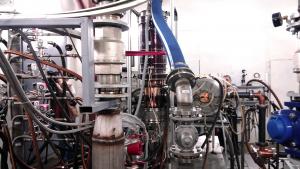Gyrotrons
In Russia, that makes two
4 Jun 2018
-
Alexander Petrov, ITER Russia
In mid-May, factory acceptance tests were successfully carried out on the second gyrotron of the Russian procurement program by specialists at the Institute of Applied Physics and GYCOM Ltd.
Gyrotrons are complex devices that convert the energy of oscillating electrons into a microwave beam. Twenty-four units are under development for ITER, including eight in Russia, eight in Japan, six in Europe, and two in India. Factory tests for Russia's second gyrotron (pictured) were carried out in Nizhny Novgorod, Russia, at GYCOM Ltd.
Twenty-four energy-producing devices called gyrotrons will operate on ITER as part of the machine's electron cyclotron resonance heating system. These powerful sources of microwave radiation are tasked with a number of important missions: pre-ionization ("starting" the plasma), plasma heating and current drive, and the stabilization of local instabilities.
The first gyrotron was developed at the Institute of Applied Physics (Russian Academy of Sciences) back in 1964, generating 6W at 10GHz for continuous operation. Since then, scientists around the world have steadily increased gyrotron output power and, today, ITER needs are driving the program.
The tests conducted on the second gyrotron manufactured in Russia demonstrated full compliance with ITER Organization technical requirements (1 MW power at the required 170 GHz in continuous mode).


